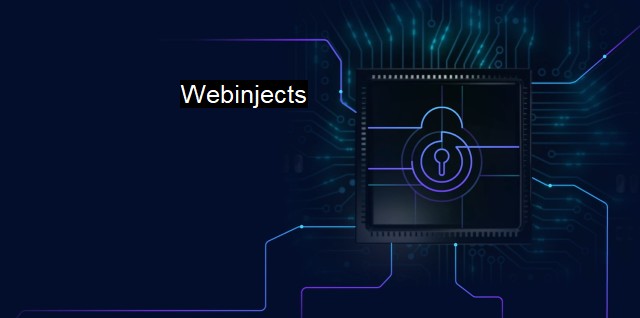What are Webinjects?
Webinjects: Exploring the Common Cyber Threat That Puts Your Business at Risk
Webinjects refers to a significant cybersecurity threat recognized in various internet ecosystems, one that particularly scars the banking industry due to illicit online losses. They are functions or payloads usually delivered by other malicious programs and designed to modify a web page’s content, with effects appearing only on the victim's end, leading to the stealing of sensitive data such as login credentials, credit card numbers among others. Unfortunately, users are usually unaware when this form of compromise takes place making it one of the prevalent attack vectors in the world of cyber threats.Technically, sequentially injected scripts alter the content of web pages loaded into the browser, all while running in the victim’s localized browser environment. It modifies web traffic in the operating system layer Namely, webinject attacks are usually brought about by malware that infects the victim's computer. Component Object Model (COM) interfaces and Application Programming Interfaces (API) underlying the computer's browser are then used, post-infection, to inject or execute malicious scripts into the viewed web pages. This approach is synonymous with a Man-in-the-Browser (MiTB) attack, a strategy overwhelmingly favored by cybercriminals due to the difficulty cybersecurity response teams face in effectively countering such incursions.
Consider a situation where a victim is attempting to log into their bank’s website; malware on the victim's device might modify the login page to include additional forms. These additional forms could demand further sensitive details that go beyond the traditional username and password, such as security codes or answers to security questions. Cybercriminals can also use webinjects to inject malicious form fields into a legitimate web page or provide an illusion that interstitial servers are mediating the transaction process, during which they can access and exploit customers' private data.
In the grand scheme of cybersecurity, webinject attacks are commonly associated with banking Trojans such as Zeus, SpyEye, and Ice IX. These Trojans are infamous for causing havoc within online banking ecosystems due to their uncanny ability to bypass two-step authentications effortlessly and observe security protocols as end-user oriented. webinject files tend to be encoded or encrypted, with target configuration lists being propagated to victim devices during runtime, further complicating matters for antivirus programs.
Containing webinjects require a multifaceted approach, given the growing sophistication of malware attacks. A robust endpoint antivirus solution remains the first line of defense against such attacks. It could prevent the initial download and installation of the malicious payload responsible for such incursions. regular updates to the antivirus signatures can effectively counter new variants of the malware that continue to emerge regularly.
Another effective means is proper employee education and routine software updates. Individuals, especially those dealing with sensitive information, should learn about these attacks and how to identify potential phishing attacks serving as carriers for such payloads. At the same time, corporations must institute regular integrated security patching and enforce updated application versions preventing attackers from exploiting the system vulnerabilities.
Network-based defenses like the intrusion detection systems (IDS)/intrusion prevention systems (IPS), sandbox surveillance, and data loss prevention (DLP) can stall a substantial volume of webinject-based invasions before they infect client endpoints or before exfiltrating sensitive data from a compromised device.
Webinject attacks are representative of the advanced form of threats that exist in the digital world today. These seemingly innocuous lines of code can trigger substantial disruptions, compromising both monetary assets and critical personal or organizational data. Consequently, the multi-layered protection and proactive approach towards patches and updates, as well as user education and vigilance, are necessary to keep this insidious online threat at bay.

Webinjects FAQs
What are webinjects?
Webinjects are pieces of malicious code that are designed to be injected into a victim's web traffic. They are often used by cybercriminals to steal sensitive information such as login credentials, credit card details or personal data.How do webinjects work?
Webinjects work by intercepting the victim's web traffic, usually through a malware infection on their computer or mobile device. They then modify the web pages being displayed to the victim, adding new fields or changing the functionality of existing ones. This allows the attacker to capture sensitive information as it is entered by the victim.How can I protect myself from webinjects?
To protect yourself from webinjects, it is important to keep your antivirus software up-to-date and to avoid downloading files from untrusted sources. Additionally, you should always be cautious when entering sensitive information into online forms, and should only do so on websites that you trust.What should I do if I suspect I have been targeted by webinjects?
If you suspect that you have been targeted by webinjects, it is important to act quickly to minimize potential damage. You should immediately disconnect from the internet and run a full virus scan on your computer or mobile device. You should also change any passwords that may have been compromised and monitor your accounts for any signs of unauthorized activity. If you are unsure what to do, you should contact a cybersecurity professional for advice.| | A | | | B | | | C | | | D | | | E | | | F | | | G | | | H | | | I | | | J | | | K | | | L | | | M | |
| | N | | | O | | | P | | | Q | | | R | | | S | | | T | | | U | | | V | | | W | | | X | | | Y | | | Z | |
| | 1 | | | 2 | | | 3 | | | 4 | | | 7 | | | 8 | | |||||||